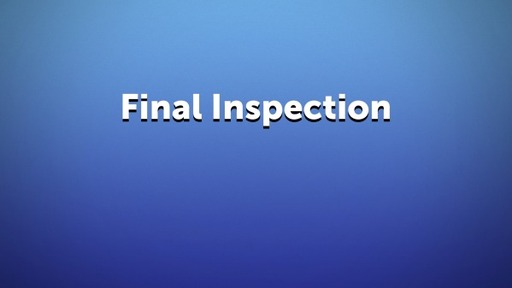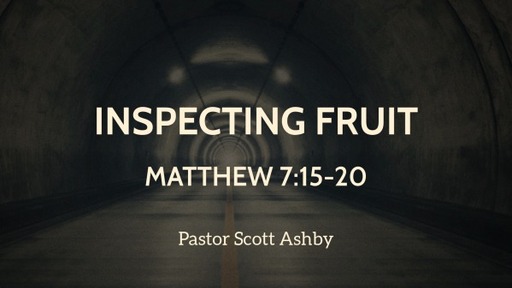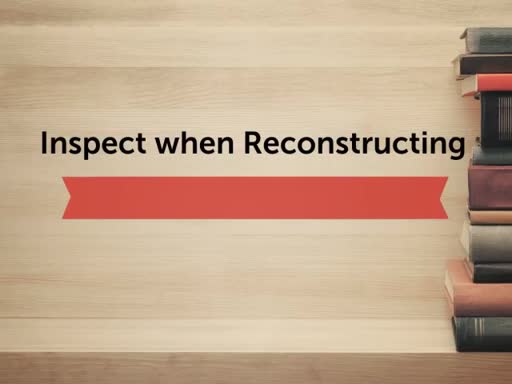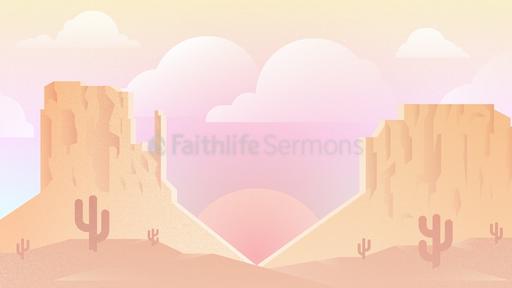Final Inspection

Notes
Transcript
Sermon Tone Analysis
A
D
F
J
S
Emotion
A
C
T
Language
O
C
E
A
E
Social
Before you can buy and move into a new house, all along the days of its construction there are times set apart for inspecting certain work that has been completed as well as a final inspection.The house can only be used when it passes the final inspection.
In the end of chapter 39, we see Moses, as God’s representative doing something similar at the tabernacle in the wilderness. When the artisans, led by Bezalel and Oholiab were finished making the various parts of the tabernacle and the clothing for the priests, they had to pass inspection. The safety of Israel was at stake. This house for God had to be right or the people would be in mortal danger. Remember, the last time the Israelites made something for worship… well, it didn’t end well!
1. Bringing the parts to the whole, vs. 33-41.
1. Bringing the parts to the whole, vs. 33-41.
They wanted to make sure they did everything right this time. They brought each piece for inspection to Moses, piece by piece.
The curtains for covering the Tent of Meeting and for separating the Holy Place from the Most Holy Place. These were a sign of the mystery and holiness of God.
The ark of the covenant--God’s royal throne on earth-- and the mercy seat, where blood was sprinkled as an atonement for sin.
The golden table for the bread of the Presence, where the priests communed with God.
The golden lampstand, symbolizing God’s life and light.
The golden altar of incense, where prayer ascended to heaven like sweet-smelling perfume.
The great bronze altar, where animals were sacrificed as a substitute for Israel’s sin, and the bronze basin for cleansing.
And they brought Aaron’s wardrobe--the holy garments for the priests to wear as they performed their sacred ministry.
A. The Tabernacle as symbol and type.
A. The Tabernacle as symbol and type.
The tabernacle was rich in its spiritual significance.
The tabernacle was God’s dwelling place on earth. Lev. 26:11
As a replica of Heaven, it taught the Israelites that their God was not some tribal deity, but the Lord God of the universe, who “stretches out the heavens like a tent (Psalm 104:2). They learned of His character. He is a mighty God , attended by angels. He is a holy God, shrouded in mystery. He is a loving God who wants to have a relationship with his people. God is the one who would give them life and light, who would provide their daily bread, who would answer their prayers, and would reveal his law for their lives. Most of all, they learned to look to God for the forgiveness of their sins.
The Tabernacle itself also points to Jesus Christ, the true tabernacle. The Israelites may not have fully understood it, but in laying out all these parts of the tabernacle for inspection by God’s man, Moses, they were laying out the gospel. God was using symbols to teach people about his saving work, long before Christ came into the world.
God’s plan was full of wisdom. Yes, He could have sent Jesus to save Adam and Eve right after they sinned. But he has chosen a better plan that would bring him more glory.
God allowed human history to unfold in all the misery of its depravity. Through the rituals of the Old Testament, God began to show what it would take to deal with the problem of sin. He did this so we would have a fuller understanding of the total salvation that he has provided for us in Jesus Christ.
The tabernacle has taught us much about holiness, about atonement, about sanctification, and about having a relationship with God. Without the tabernacle, our understanding of these great doctrines would be impoverished. But what in the OT is as a picture-book in black and white, at exactly the right time, God brought Jesus into the story in living color. The people, the events, and the institutions of the Old Testament reveal the salvation that God eventually provided in Jesus Christ. These give us the divinely ordained symbols and types revealing the basic truths of salvation in Christ.
B. The lessons from the Tabernacle.
B. The lessons from the Tabernacle.
With the tabernacle, nearly everything was symbolic. It clearly represented the house of God, and nearly all its parts symbolized something about His relationship with his people.
What can we learn from the symbolism of the Tabernacle? From Vern Poythress, here are eight important lessons:
First, it reminded the Israelites that God was the true God of the whole universe, not some god confined to a spot.
Second, it depicted for the Israelites the way in which God’s care was demonstrated in their day-to-day circumstances. Food, light, and life all derived from God who made the whole universe as His dwelling place and their--and our--home.
Third, the tabernacle as a unique structure reminded the Israelites that they had unique privileges. They alone God chose to be His people, and condescended to live among them in a special way.
Fourth, it represented Eden, reminding the Israelites of their sinful, lost, separated condition as descendents of Adam. Entrance into Eden was barred to them. And yet they could enter in a sense, when the priest entered as their representative. The tabernacle spoke bot of being lost and also the promise of overcoming sin through a representative man, ultimately through Jesus Christ our final High Priest...
Fifth, it symbolized the people of God corporately, who were to imitate the beauty, order, holiness, and purity of the tabernacle itself in their own communal living.
Sixth, it also symbolized the people of God individually. The Israelites were commanded to keep their bodies pure, pure first from sin but also from ceremonial defilements that symbolized sin. Today the bodies of Christians are the temples of the Holy Spirit. We are to “cleanse ourselves from all defilement of flesh and spirit, perfecting holiness in the fear of God” (2 Cor. 7:1).
Seventh, it points forward to the new Jerusalem, the final dwelling of God with human beings.
Eighth, it symbolized God Himself… [T]he Israelites were being instructed by the veils and the not-fully-analyzable symbols to realize that God’s character and His purposes were unfathomably deep, and that their salvation rested in God’s own character and wisdom. ...The tabernacle points forward to Christ the final dwelling of God with human beings, but also to the Father and the Spirit who in Christ reveal the fullness of the deity to us (Poythress, The Shadow of Christ in the Law of Moses, pp. 35–37).
2. The Inspection of the parts, vs. 32,42-43.
2. The Inspection of the parts, vs. 32,42-43.
To fulfill its divinely ordained purpose of revealing the character of God and the way of salvation in Christ, the tabernacle had to be made exactly the way God said. The man responsible to see whether it met God’s standard? The prophet Moses. He scrutinized their work.
Even before hearing His verdict, we know that the tabernacle will pass with flying colors. How? Repeatedly we are told in the Bible that the Israelites made everything the way God told them to make it. Exodus 36, which tells us how the tabernacle was made, repeats Exodus 26 almost verbatim, showing that God’s instructions were followed down to the last loop on the last curtain and the last hook on the last post. The same is true of Exodus 37, which told of the making of the furniture, and Exodus 38, the courtyard. The Israelites were extremely careful in following the original instructions from God through Moses. Exodus 39 makes this even clearer. This phrase, “as the LORD commanded Moses,” occurs seven times in this chapter, emphasizing the Israelites made the tabernacle just as God told them. The Bible summarizes all this by saying
Thus all the work of the tabernacle of the tent of meeting was completed; and the sons of Israel did according to all that the Lord had commanded Moses; so they did.
Again at the end of the inspection, the same phrase appears again:
So the sons of Israel did all the work according to all that the Lord had commanded Moses.
Biblical scholars call this an inclusio. The list of what was brought for inspection both begins and ends with an affirmation that they did exactly what God commanded them to do. But Moses still had to examine their work. Only he had seen the prototype for the tabernacle on God’s mountain.
“Then you shall erect the tabernacle according to its plan which you have been shown in the mountain.
As the project manager, Moses was the only one who had met with the Architect. Afterwards, he was able to tell the contractors (Bezalel and his associates) what their client wanted.
It did not take long for Moses to reach his verdict. Construction of the parts come to a close in verse 43:
3. The blessing of obedience, v. 43.
3. The blessing of obedience, v. 43.
And Moses examined all the work and behold, they had done it; just as the Lord had commanded, this they had done. So Moses blessed them.
When God’s work is done in God’s way, it always has God’s blessing. We can say God’s blessing because it really was his blessing that the people received. Moses was the one who pronounced the benediction, but he did it on God’s behalf. As the mediator, he spoke to the people for God. And when he saw that they had done everything right, he placed God’s seal of approval on their work. His blessing was more than a word of encouragement; it meant that the powerful grace of Almighty God would be with them for good.
When God’s work is not done in God’s way, it does not have God’s blessing. The Israelites learned this when they worshiped the golden calf. They thought they were doing God’s work. They claimed to be worshiping the one true God. But really they were doing their own work their own way, and thus they could not have God’s blessing. Rather than waiting for God to reveal his will for their worship, they decided to worship him by images, which were forbidden in the second commandment. As a result, they received God’s curse instead of his blessing.
But this time the Israelites got it right. Rather than doing things their own way, they did them God’s way. And they did it for the right reason: They wanted to glorify God. After reading this passage, a man who works in architecture and design noted how unusual it is for a project the size of the tabernacle to pass inspection perfectly on the first attempt. He said this would only happen if the workers were highly motivated to please their client. In this case, the client was the God who made Heaven and earth and who had delivered his people from slavery. For him no expense was spared, no corner was cut, no detail was overlooked. The Israelites wanted to please the God of their salvation, and as a result, their work enjoyed the smile of his blessing.
4. Our Final Inspection.
4. Our Final Inspection.
As Christians, we work for God knowing that one day there will be a final inspection, what theologians call “the Bema Seat judgment.”
For we must all appear before the judgment seat of Christ, so that each one may be recompensed for his deeds in the body, according to what he has done, whether good or bad.
Jesus said,
“Behold, I am coming quickly, and My reward is with Me, to render to every man according to what he has done.
Just as the Israelites laid out the tabernacle for Moses, so our lives will be laid out before God, who alone knows all our secrets.
What blessing will we receive then? Have we offered such perfect obedience that we can pass inspection?
God will examine everything that we have done, according to the perfect standard of his justice. For those who have done his work in his way, there will be blessing upon blessing. God has promised that we will receive a fair return for all our labor; he will “reward everyone for whatever good he does” (Eph. 6:8; cf. Matt. 16:27). But our good works will not be the basis for our salvation. Although we will be rewarded for them, we will not be saved by them. We cannot be saved by them because even the best of all our efforts cannot meet the standard of God’s perfection.
But thankfully, before inspecting us there is something else that God will inspect first. He will inspect the finished work of Jesus Christ, the tabernacle of our salvation. And when he looks at Jesus, he will see the perfect righteousness of the only man who ever did everything just as God commanded. Then God will pronounce his blessing—not simply on Jesus, but also on everyone who trusts in Jesus. The only way to endure the final judgment is to trust in Jesus Christ. When we put our faith in him, he becomes “our righteousness” (1 Cor. 1:30), and we are able to pass God’s inspection.
ADVERTISEMENT
Related Media
See moreRelated Sermons
See more

Graceway Baptist Church, Milton, Ontario, Canada • 8 views • 38:57


Concord Missionary Baptist Church • 419 views • 34:57


Woodville Baptist Church • 19 views



